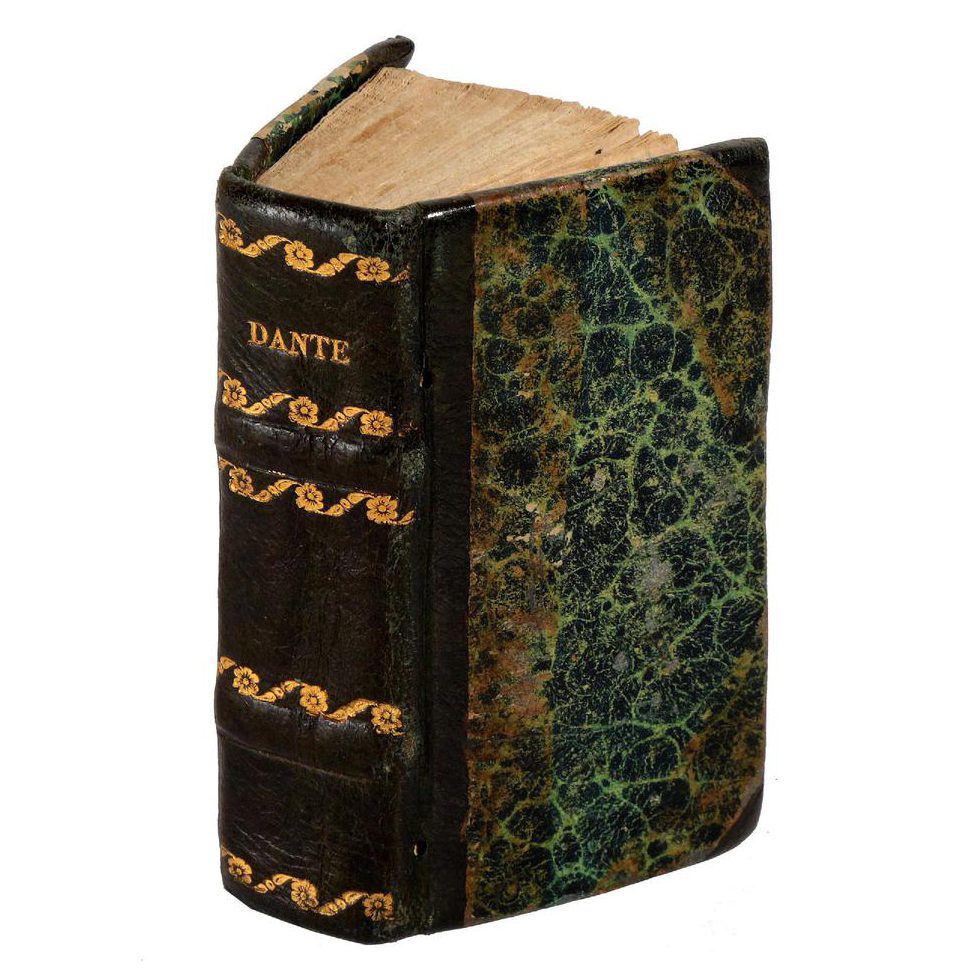Alighieri, Dante (1265-1321). Dante col sito, et forma dell’Inferno. [Venice, Alessandro Paganini, ca. 1516].


Alighieri, Dante (1265-1321). Dante col sito, et forma dell’Inferno. [Venice, Alessandro Paganini, ca. 1516].
Alighieri, Dante (1265-1321).
Dante col sito, et forma dell’Inferno.
[Venice, Alessandro Paganini, ca. 1516].
The Dantino Paganini in the ‘long 24mo’ format
Alighieri, Dante (1265-1321).
Dante col sito, et forma dell’Inferno. [Venice, Alessandro Paganini, ca. 1516].
24° (95x47 mm). Collation: A-X8, AA-DD8, EE4. 202, [2] leaves. Italic and gothic type. Blank spaces for capitals at the beginning of each cantica. One double-page woodcut plan of Hell (fols. EE2v-EE3r), three full-page woodcut diagrams of categories of sins punished in Hell (fols. EE3v-EE4r), and in Purgatory (fol. EE4v). Early nineteenth-century three-quarter green morocco, marbled covers. Spine with two small raised bands, decorated with narrow frieze, author's name lettered in gilt. In a green half-morocco case. A good copy. One small wormhole at the gutter of the first leaf, affecting a few letters. Minor repair to the gutter of fol. A8, quires C-E waterstained. The lower margins of the woodcuts slightly trimmed.
Provenance: 'Di Bern. Capiri in dono' (old ownership inscription on the title-page).
The exceedingly rare Paganini edition of the Commedia – the first edition printed in the innovative long 24° format – presented here in the state with leaves numbered with arabic numerals, except for fols. IX, X, and XV. It is the smallest printed Commedia of the Renaissance, known as the Dantino. The volume is part of the series begun by Paganini in the same year, which opens with Petrarch's Rime, Bembo's Asolani , and Sannazaro's Arcadia, all dedicated by the printer to pre-eminent contemporaries and patrons. This edition was addressed by the printer to no less than the cardinal Giulio de' Medici, who, in 1523, became Pope Clement VII. The date is not present in the book, but it belongs to the period before Paganini's move to Toscolano.
The last three leaves contain a double-page and three full-page woodcuts, all appearing here for the first time. The double-page woodcut, showing the plan of Hell, is signed by the engraver 'I.A.', possibly the Venetian artist and cartographer Giovanni Andrea Vavassore, also known as Guadagnino.
“It is believed that Bembo was active with publishers in Venice at his time. According to his friend Trifon Gabriele, Bembo was responsible for the analysis of the structure in Paganini's 1515 edition of Dante and therefore, presumably, of the structurel analyses of all three realms in Aldus's Dante, also of 1515. It has been suggested that Paganini pirated the tree of sins which Bembo drew for Aldus. However Bembo and Paganini seem to have been on good terms since Paganini republished Gli Asolani in 1515, in his new and elegant pocket book size collection of Latin and Italian classics [...] Although his copyright had expired after ten years, Aldus reprinted Gli Asolani himself, also in 1515” (C. Kidwell, Pietro Bembo. Lover, Linguist, Cardinal, Montreal-London 2004, p. 183).
Adams D-337; STC Italian 209; Nuovo, Alessandro Paganino (1509-1538), Padova 1990, no. 28; R. Sturel. “Recherches sur une collection in -32 publié en Italie au début du XVie siècle”, Revue des Livres anciens, 1 (1913), pp. 50-73: 57; Batines i, pp. 77-24; Mambelli 26; Essling 540-541; Sander 2323-2324; Philobiblon, One Thousand Years of Bibliophily, no. 62.

